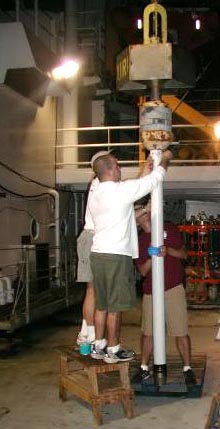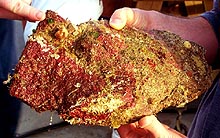
Scientists from the University of Rhode Island prepare the coring apparatus for sampling sediments around the volcano. From left to right: Scott Lundin, Steven Carey and David Smith. Click image for larger view.
Geology of the Kick'em Jenny Volcano
Debby Kay, Web Coordinator
NOAA Research
The most active volcano in the Lesser Antilles volcanic arc, Kick’em Jenny, provides scientists with a rare opportunity to examine the growth processes of submarine seamounts into emerging island structures.
Kick’em Jenny is five nautical miles north of Grenada at latitude 12017.96’North and Longitude 61038.25’West. It entered recorded history on July 24, 1939, with an enormous spew of black ash and steam rising from the relatively tranquil sea. Earthquakes and tremors followed its eruption, along with explosions caused by the mixing of hot molten rock and seawater.
History
Since its first recorded eruption, Kick’em Jenny has remained very active. The University of West Indies (UWI) operates a remote seismic observatory in Sauteurs, Grenada which has prepared a chart listing the major events of Kick’em Jenny.
Most eruptions as shown in this table are detected by the slow-tracking Tertiary phase seismic signals. This phase of acoustic energy is basically the trembling of the sea floor. As a submarine volcano grows toward the surface, depending on the composition of the magma and the interaction of this composition with seawater, the potential for explosive eruption increases. There is little information available regarding the nature of submarine deposits with a composition similar to Kick’em Jenny.

A rock sample collected near the volcano covered with red-colored bacterial mats. Click image for larger view.
Petrology and Geochemistry
The magma of Kick’em Jenny is generally an alkali basalt type with a mineral composition that indicates it originates within the lower crust. Sigurdsson (1973) demonstrated that all the volcanoes of the Antilles arc lie above a subduction zone of two lithospheric plates. The activity of these volcanoes is a result of the gradual westward drift of one plate and its thrusting under the adjoining plate.
The rock samples collected on the flanks of Kick’em Jenny exhibit an increase in gray pumice and lithics, suggesting possible mixture of material from different eruptive events. Work by Balance et al., in 1988 show samples of dark basaltic scoria and gray pumice, feldspar crystals, mafic crystals, lithics, and minor biogenic material. The samples are very rich in primary volcanic material and generally lacking in significant amounts of biogenic fragments. This suggests that they are relatively young and have not suffered from significant admixture with non-volcanic sediment. Samples collected near the crater contain the highest proportions of dark basaltic scoria. These represent the products of recent explosive eruptions.
Morphology
Sampling of the crater and the flanks during a multibeam survey in 2002 by W. Douglas Wilson and others on the NOAA research vessel Ronald H. Brown revealed that the dominant products of the volcano were pyroclastic deposits and pillow lavas of amphibole-rich basalts and basaltic andesites. The morphology of the Kick’em Jenny volcano revealed by that multibeam survey is shown here.
The survey shows a larger 5 km-wide, horseshoe-shaped and west-facing depression formed by slope failure and associate debris avalanche. Gravitational collapse of the steep and unstable slopes of these arc volcanoes is an important mechanism for the generation of debris avalanches. It is likely the large arcuate scar surrounding Kick’em Jenny formed by a similar mechanism. Submersible dives in 1989 shortly after the 1988 eruption determined that the volcanic cone consisted of both pyroclastic deposits and pillow-like lava flow units. The summit region had the remnants of a lava dome and a breached crater.
For complete and current information on the activitiy of the Kick 'em Jenny Volcano, please visit the UWI seismic research station ![]() .
.



